Using ingredients straight from the fridge

The application and management of heat is arguably the most vital aspect of baking. Ovens require preheating, sugars need to reach specific boiling points, and temperatures must be meticulously monitored throughout the process. However, all these adjustments rely on the assumption that conditions are consistent from the start. Therefore, one crucial baking step that should never be overlooked is using room-temperature ingredients, such as the eggs in your cookies and the butter in your batter.
Baking a cake depends on established techniques with a singular aim: to blend the ingredients into a uniform mixture. Creaming sugar with cold butter straight from the fridge complicates this blending process. The same applies to cold eggs.
This added difficulty leaves you with two options. First, you can stop mixing before the batter is fully combined, which often leads to an uneven, dry texture with overly moist areas. Alternatively, you risk overmixing the batter, which also yields subpar results. When folding in dry ingredients, the goal is to incorporate air bubbles that allow the leavening agents to work effectively. Overmixing, however, activates the gluten in the flour, resulting in a tough, dry cake.
Skipping the sift
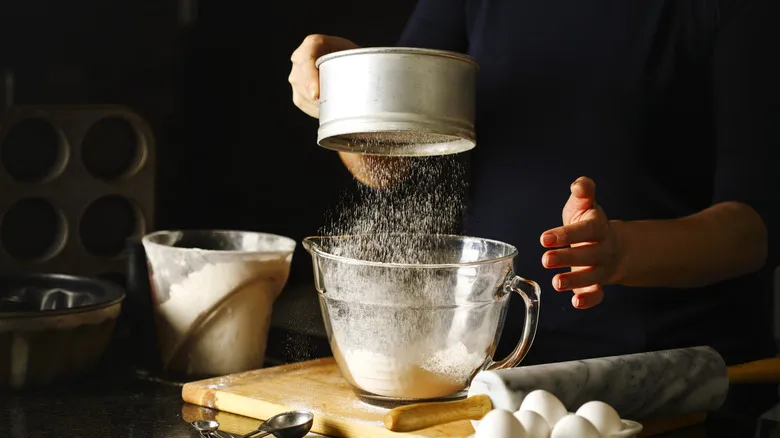
Baking a cake often revolves around two key components: the wet and the dry. The process of combining the wet ingredients is usually more intricate, while mixing the dry ingredients can sometimes feel like an afterthought. However, neglecting this step can lead to problems.
Many recipes recommend using a sieve when adding flour for two main reasons. First, it ensures accuracy. Flour is typically measured by volume rather than weight, and any hidden clumps in your measuring cup can distort the measurement. Adding too much flour results in a dry crumb that may crack, while too little can leave the cake overly moist.
The second reason bakers sift flour is to incorporate air, resulting in a lighter powder that blends more easily into the batter. That said, not all dry ingredients require sifting. Many deliciously gooey cookie recipes skip this step entirely, as do most bread loaves and various denser cakes. However, as a general guideline, if a recipe instructs you to fold in the dry ingredients, it’s aiming for a light batter, and that’s when you should definitely use a sifter. If you don’t have a flour sifter, a fine mesh sieve can serve as a good alternative, or you can use a balloon whisk to help break up any lumps in your dry mixture.
Microwave shortcuts
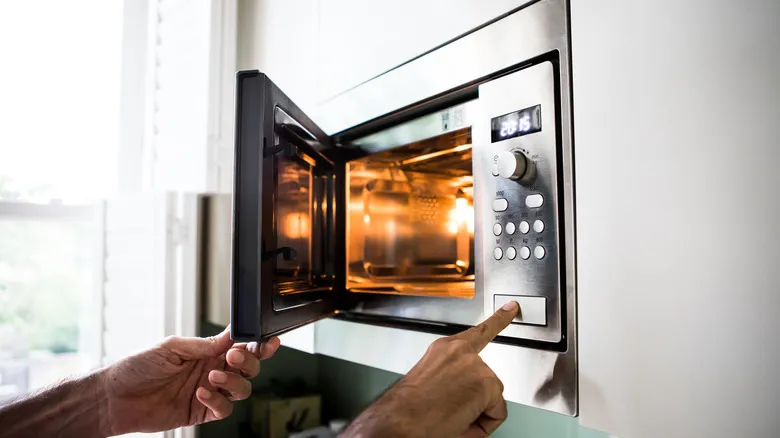
Baking a cake often feels like a marathon, with each phase marked by bursts of activity interspersed with long stretches of waiting. The microwave can be a helpful companion in this endeavor, providing quick and convenient shortcuts that can simplify the process. However, as many novice bakers discover to their frustration, some of these time-saving techniques can backfire. Take ganache, for instance—a straightforward two-ingredient sauce made from bittersweet chocolate and cream, ideal for drizzling over desserts, filling rich macarons, or layering between sponge cake.
There are two classic methods for preparing ganache. The first involves heating the cream on the stovetop and then pouring it over the chocolate, mixing until a smooth emulsion forms. Alternatively, you can melt the chocolate in a double boiler and then incorporate the cream. While the popular shortcut of melting chocolate in the microwave is certainly faster, it can burn unexpectedly, resulting in a chalky and bitter texture. Similarly, heating cream in the microwave is risky, as it often bubbles over without warning.
The pitfalls don’t stop there. Tips suggesting that you can quickly bring butter or other ingredients to room temperature using the microwave often yield disappointing results. Additionally, while baking a cake in the microwave may take less than five minutes, it typically results in a rubbery and unsatisfactory outcome.
Throwing everything in and hitting mix
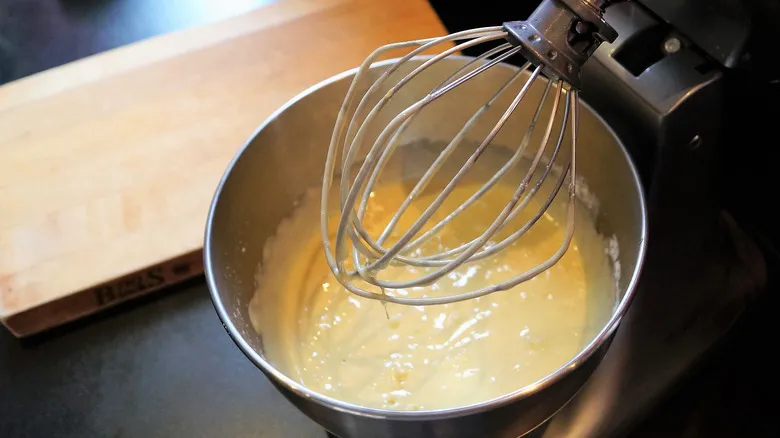
All-in-one cakes are currently very popular. However, like many quick online solutions, they often don't deliver as promised. Similar to one-pot pasta recipes, the concept involves combining all ingredients at once and starting to cook—or in the case of cake batter, mixing—right away. While this approach seems like a simpler way to accomplish the task with minimal hassle, there’s a downside: it often doesn’t work. Even in the best-case scenario, the results are subpar.
Mixing wet and dry ingredients together saves time but leads to complications later on. The objective of creating cake batter remains unchanged: you want a smooth, glossy, and uniform mixture. Yet, the essential steps you bypassed—creaming the sugar, sifting the flour, and gradually adding eggs—still need to be performed, but now with added difficulty. Achieving the right batter consistency requires a much longer mixing time, which can result in a tough, flat cake.
There’s a reason for mixing wet and dry ingredients separately before combining them. It’s all about ensuring even distribution, incorporating air, and, importantly, minimizing mixing. Even the leavening agents must be thoroughly integrated. Neglecting this can lead to clumps of overly wet flour that may rise too much, resulting in an uneven or potentially cracked cake.
Eyeballing the ingredients
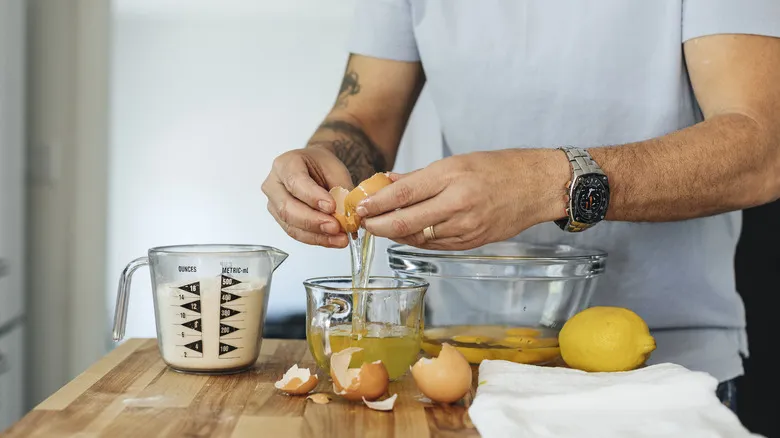
Every chef understands that tasting throughout the cooking process is crucial. Your taste buds help assess seasoning, ingredient balance, and whether a dish needs more cooking time. Baking, however, is a different story; it’s all about chemistry.
You can’t taste raw batter, which makes precise measurement of ingredients essential. For one, it’s not safe to consume; raw flour may harbor E. coli, and raw eggs can contain salmonella. Even aside from safety concerns, there are compelling reasons to avoid rough estimates in baking.
Cakes can be quite temperamental. As we've noted, too much flour leads to dense cakes, while too little creates a soggy mess. Other elements are equally important. Leavening agents must be measured in relation to the amounts of flour, eggs, sugar, and butter used. Self-rising flour simplifies this somewhat, but accurate measurements are key to avoiding many common baking mishaps. While some seasoned bakers may take risks with minor adjustments based on their extensive experience, for most of us, it’s best to adhere strictly to the measurements provided in recipes.
Skipping the tap

Baking involves a variety of steps, some of which feel endless, while others are quick and straightforward. It’s easy to dismiss the latter as optional in your baking process, but you’d be mistaken when it comes to the tapping technique. The concept is simple: once your cake batter is in the tin, lift it above the counter and drop it back down with a moderate force. Repeat this several times, rotating the tin as you go. This tap-and-spin method offers two key advantages for your final product.
First, it helps to level the cake, eliminating the need to trim uneven edges after baking, which can be time-consuming and requires skill. Second, it helps to release any trapped air bubbles. The goal of aerating the batter is to create tiny pockets of soluble air, which keeps the cake light and allows the leavening agents to work effectively. However, large air pockets can lead to tunneling, resulting in a cake that has a Swiss cheese appearance, a bubbled surface, or an unsightly bulge that can be challenging to decorate.
When executing the tap, it’s important to be cautious. For those aiming to achieve the perfect brownie, a firm tap about fifteen minutes into baking can help create a denser, fudgier texture. However, for lighter cakes, you should be more gentle with your tapping technique.
Skipping the chill

It's well-known that temperature plays a vital role in the baking process, but there's another side to all that heat: cakes also require time to cool. There are two key moments in baking when cooling is essential. The first occurs before baking. Many cookie doughs need to chill for at least thirty minutes, and some bakers recommend refrigerating sugar cookie dough overnight for even better results. This chilling helps prevent cookies from spreading excessively during baking. Similarly, the base of a cheesecake requires a certain firmness. Regardless of the cheesecake type, chilling the base for at least an hour creates a stable surface for the cream cheese mixture.
However, the need to cool after baking is arguably even more important. Traditional cakes are placed on a wire rack to cool for a good reason. Hot cakes are fragile and difficult to handle, while frosting won’t adhere properly, and any attempt to apply ganache will likely result in a melted disaster.
Cheesecake, in particular, requires extra care during the cooling phase. Turning off the oven and slightly opening the door allows the cheesecake to lose heat gradually, which helps prevent the custard from cracking. Even after it reaches room temperature, it's important to resist the temptation to dig in. For optimal results, a cheesecake should always be left in the refrigerator—never the freezer—to chill overnight.
Adding drop-in ingredients without flouring them first
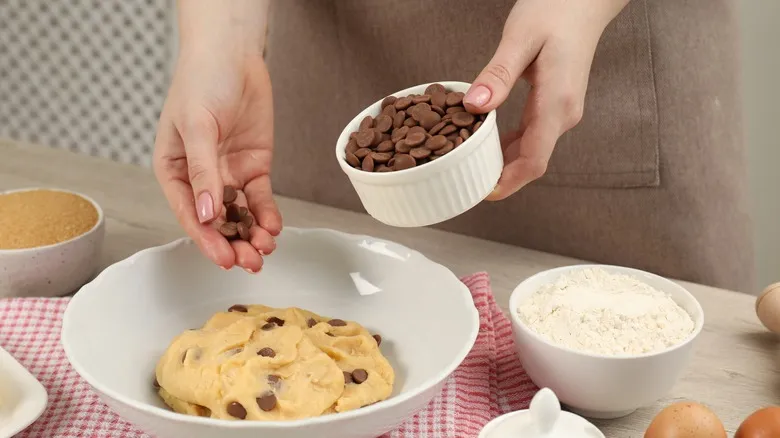
Many recipes suggest adding ingredients to the batter just before baking. These ingredients can include dried fruits, nuts, berries, and, of course, chocolate chips. However, the issue with this method is that most of these additions are denser than the cake batter, causing them to sink to the bottom. A simple solution is to coat these items in flour before mixing them in.
The flour serves a dual purpose. Firstly, it absorbs excess moisture, making the ingredients less slippery. Secondly, it adds texture, providing something for the batter to grip onto as the added ingredients remain suspended.
A light dusting of flour is sufficient—using too much can disrupt the overall flour balance of the cake, leading to undesirable outcomes. Once coated, gently add each ingredient one at a time, rotating the bowl as you go, and then give the mixture a gentle stir to ensure an even distribution.
Reading the recipe as you go

When it comes to baking blunders, neglecting to read a recipe beforehand ranks among the most significant missteps. Recipes often contain unexpected details hidden within the text, and while it may be tempting to dive right in after noting the first ingredient, you’re likely to encounter issues before you finish.
Most recipes begin with a list of ingredients, and the first step for most people is to ensure they have everything on hand or to create a shopping list. Once you’ve gathered all your supplies, the next step is to turn on the oven and preheat it to the required temperature. Properly calibrating your oven can be extremely beneficial at this stage.
After completing these initial steps, you enter a bit of a culinary free-for-all. Baking a cheesecake serves as a prime example. Early instructions—like the necessity of using cream cheese at room temperature—can lead to complications if you start measuring out the sugar while the cream cheese remains chilled. Even worse, if you don’t read through to the end, you might discover that the cheesecake you’ve prepared for tonight’s dinner party won’t be ready until the next day.
Taking the time to thoroughly read the entire recipe helps you avoid any unpleasant surprises that an unfamiliar recipe might present. Equipped with all the essential information and aware of potential pitfalls, you’re much more likely to achieve the results you envisioned.
Recommended
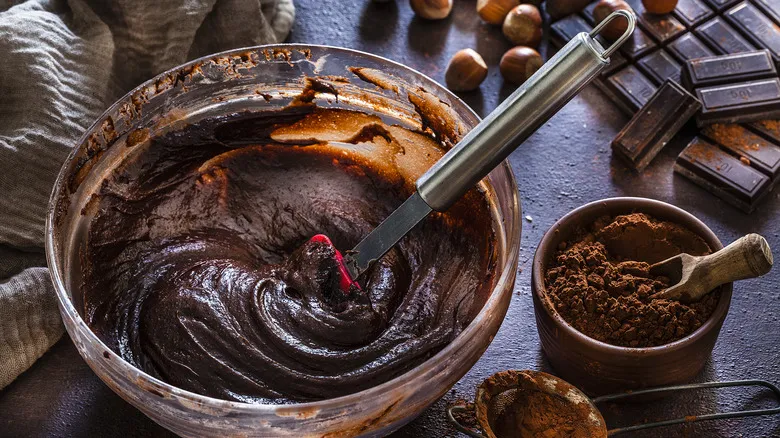
Your Boxed Mix Cake Will Taste Like Heaven With One Simple Swap

The Easiest Way To Test Baking Soda And Powder Freshness

13 Canned Fruits You Should Have In Your Pantry

What Is 00 Flour And Why Does Your Recipe Call For It
Next up

